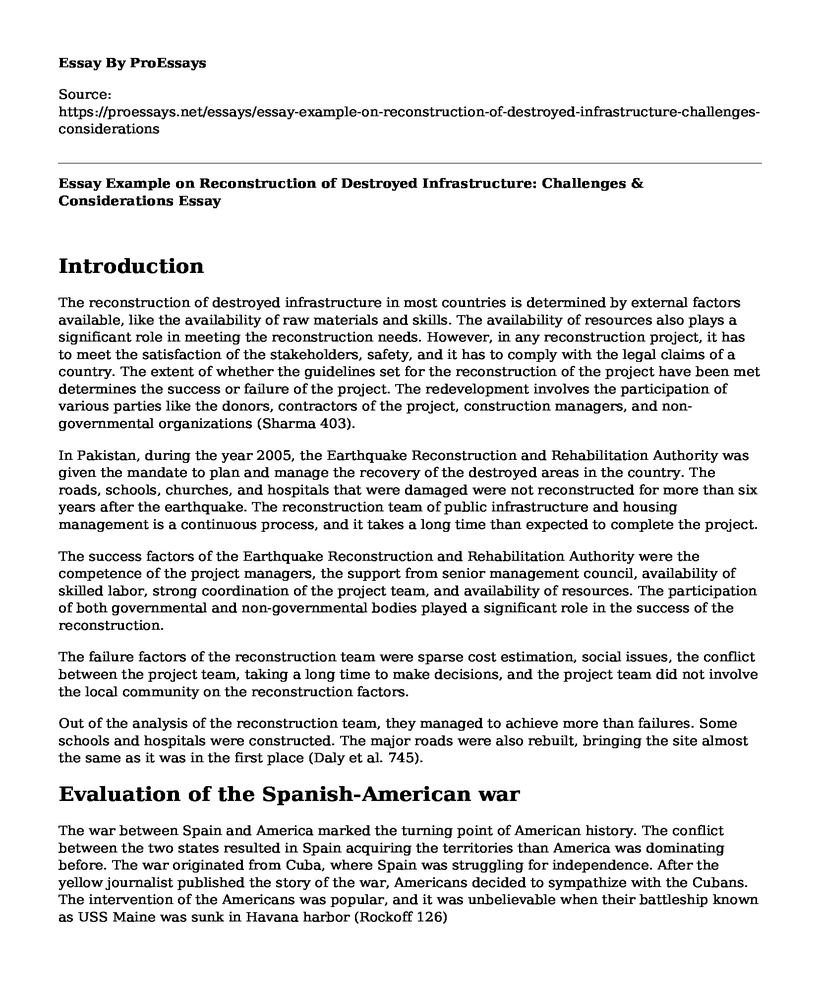Introduction
The reconstruction of destroyed infrastructure in most countries is determined by external factors available, like the availability of raw materials and skills. The availability of resources also plays a significant role in meeting the reconstruction needs. However, in any reconstruction project, it has to meet the satisfaction of the stakeholders, safety, and it has to comply with the legal claims of a country. The extent of whether the guidelines set for the reconstruction of the project have been met determines the success or failure of the project. The redevelopment involves the participation of various parties like the donors, contractors of the project, construction managers, and non-governmental organizations (Sharma 403).
In Pakistan, during the year 2005, the Earthquake Reconstruction and Rehabilitation Authority was given the mandate to plan and manage the recovery of the destroyed areas in the country. The roads, schools, churches, and hospitals that were damaged were not reconstructed for more than six years after the earthquake. The reconstruction team of public infrastructure and housing management is a continuous process, and it takes a long time than expected to complete the project.
The success factors of the Earthquake Reconstruction and Rehabilitation Authority were the competence of the project managers, the support from senior management council, availability of skilled labor, strong coordination of the project team, and availability of resources. The participation of both governmental and non-governmental bodies played a significant role in the success of the reconstruction.
The failure factors of the reconstruction team were sparse cost estimation, social issues, the conflict between the project team, taking a long time to make decisions, and the project team did not involve the local community on the reconstruction factors.
Out of the analysis of the reconstruction team, they managed to achieve more than failures. Some schools and hospitals were constructed. The major roads were also rebuilt, bringing the site almost the same as it was in the first place (Daly et al. 745).
Evaluation of the Spanish-American war
The war between Spain and America marked the turning point of American history. The conflict between the two states resulted in Spain acquiring the territories than America was dominating before. The war originated from Cuba, where Spain was struggling for independence. After the yellow journalist published the story of the war, Americans decided to sympathize with the Cubans. The intervention of the Americans was popular, and it was unbelievable when their battleship known as USS Maine was sunk in Havana harbor (Rockoff 126)
Later Spain granted Cuba powers to govern themselves, but the controls were limited. America, on the other side, issued full self-governance of the Cuban government and directed the Spanish army to withdraw from the Cuban territory. Then the war was declared between Spain and America.
The Spanish-American war came to an end when the two countries signed a treaty of Paris. Americans were the ones who won the battle and emerged as a superpower country. It also took a new stake in international politics that later determined its role in the affairs of European countries and the rest of the world.
After the war, the Americans expanded their territories where it started trading with the Asians. The trade earned the American merchants and manufacturers millions. This profitable trade made Americans have a more substantial influence on Asian countries (Graber 765).
From an economic perspective, the war also benefited Spain. The flow of capital helped Spain to develop in its industries of textile and steel. When they were defeated in the battle by Americans, they started to weaken economically.
Works Cited
Daly, P., Ninglekhu, S., Hollenbach, P., Duyne Barenstein, J., & Nguyen, D. "Situating local stakeholders within national disaster governance structures: rebuilding urban neighborhoods following the 2015 Nepal earthquake." Environment and urbanization 29.2 (2017): 403-424. https://journals.sagepub.com/doi/pdf/10.1177/0956247817721403
Graber, Jennifer. "The Cross of War: Christian Nationalism and US Expansion in the Spanish-American War by Matthew McCullough." Register of the Kentucky Historical Society 113.4 (2015): 764-766.
Rockoff, Hugh. America's economic way of war: war and the US economy from the Spanish-American War to the Persian Gulf War. Cambridge University Press, 2012: 125-127. http://www.miwsr.com/2013-046.aspx
Sharma, Keshab. "Challenges of reconstruction after 2015 Nepal earthquake and comparison with Haiti and Chile reconstruction." Proc. of 2nd NESA Symposium, University of Alberta, Edmonton, AB, Canada. 2017. 403-424. https://www.researchgate.net/profile/Keshab_Sharma3/publication/316753970_Challenges_of_reconstruction_after_2015_Nepal_earthquake_and_a_comparison_with_Haiti_and_Chile_reconstruction/links/5910c691aca272ec9a1af5a5/Challenges-of-reconstruction-after-2015-Nepal-earthquake-and-a-comparison-with-Haiti-and-Chile-reconstruction.pdf
Cite this page
Essay Example on Reconstruction of Destroyed Infrastructure: Challenges & Considerations. (2023, Sep 01). Retrieved from https://proessays.net/essays/essay-example-on-reconstruction-of-destroyed-infrastructure-challenges-considerations
If you are the original author of this essay and no longer wish to have it published on the ProEssays website, please click below to request its removal:
- History Essay: Ancient Egypt and Mesopotamia. Ancient Minoan and Western Civilization
- Beto O'Rourke Biographical Essay
- Martin Luther Kings and the Fights for Civil Rights Essay
- Article Summary: Entrepreneurship in American History
- Essay Example on the Weakness of Technology in Warfare
- Essay Sample on Exploring Egypt's Ancient Art & Architecture: A Historical Journey
- Essay Sample on Social Security Act of 1935: A Federal Policy Change for the Elderly







